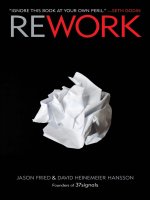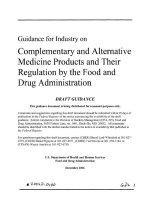Engineering economic 14th by william sullivan and koeling ch 10
Bạn đang xem bản rút gọn của tài liệu. Xem và tải ngay bản đầy đủ của tài liệu tại đây (175.01 KB, 25 trang )
Engineering Economy
Chapter 10: Evaluating Projects with
the Benefit-Cost Ratio Method
Engineering Economy, Sixteenth Edition
By William G. Sullivan, Elin M. Wicks, and C. Patrick Koelling
Copyright ©2015 by Pearson Education, Inc.
Upper Saddle River, New Jersey 07458
All rights reserved.
The objective of Chapter 10 is to
demonstrate the use of the
benefit-cost ratio for the
evaluation of public projects.
Engineering Economy, Sixteenth Edition
By William G. Sullivan, Elin M. Wicks, and C. Patrick Koelling
Copyright ©2015 by Pearson Education, Inc.
Upper Saddle River, New Jersey 07458
All rights reserved.
Public projects are unique in many ways.
• Frequently much larger than private ventures
• They may have multiple, varied purposes that
sometimes conflict
• Often very long project lives
• Capital source is ultimately tax payers
• Decisions made are often politically influenced
• Benefits are often nonmonetary and are difficult to
measure
• more...
Engineering Economy, Sixteenth Edition
By William G. Sullivan, Elin M. Wicks, and C. Patrick Koelling
Copyright ©2015 by Pearson Education, Inc.
Upper Saddle River, New Jersey 07458
All rights reserved.
These elements make engineering
economy studies more challenging.
• The Flood Control Act of 1936 requires that
benefits must exceed costs to justify
federally funded projects, this is a criterion
now used in most public projects.
• There can be difficulty defining benefits,
and even in establishing costs.
Engineering Economy, Sixteenth Edition
By William G. Sullivan, Elin M. Wicks, and C. Patrick Koelling
Copyright ©2015 by Pearson Education, Inc.
Upper Saddle River, New Jersey 07458
All rights reserved.
For any project, the proper perspective is
to consider the net benefits to the owners
of the enterprise.
• For government projects, the owners are ultimately
the taxpayers.
• Benefits are favorable consequences of the project
to the public (owners).
• Costs represent monetary disbursements required
of the government.
• Disbenefits represent negative consequences of a
project to the public (owners).
Engineering Economy, Sixteenth Edition
By William G. Sullivan, Elin M. Wicks, and C. Patrick Koelling
Copyright ©2015 by Pearson Education, Inc.
Upper Saddle River, New Jersey 07458
All rights reserved.
Self-liquidating projects are expected to
repay their costs.
• These projects generally provide utility services
(power, water, toll roads, etc.).
• They earn direct revenue that offset their costs, but
they are not expected to earn profits or pay taxes.
• In some cases in-lieu payments are made to
governments in place of taxes and fees that would
have been paid had it been under private
ownership.
Engineering Economy, Sixteenth Edition
By William G. Sullivan, Elin M. Wicks, and C. Patrick Koelling
Copyright ©2015 by Pearson Education, Inc.
Upper Saddle River, New Jersey 07458
All rights reserved.
Cost allocations in multiple-purpose,
public-sector projects tend to be arbitrary.
• Some projects naturally have multiple
purposes—e.g., construction of a dam.
• Some of the costs incurred cannot properly
be assigned to only one purpose.
• Purposes may be in conflict.
• Often support for a public project, and its
many purposes, is politically sensitive.
Engineering Economy, Sixteenth Edition
By William G. Sullivan, Elin M. Wicks, and C. Patrick Koelling
Copyright ©2015 by Pearson Education, Inc.
Upper Saddle River, New Jersey 07458
All rights reserved.
Difficulties inherent in engineering
economy studies in the public sector.
• Profit standard not used to measure effectiveness
• Monetary effect of many benefits is difficult to
quantify
• May be little or no connection between the project
and the public (owners).
• Often strong political influence whenever public
funds are used, with little consideration to longterm consequences.
Engineering Economy, Sixteenth Edition
By William G. Sullivan, Elin M. Wicks, and C. Patrick Koelling
Copyright ©2015 by Pearson Education, Inc.
Upper Saddle River, New Jersey 07458
All rights reserved.
Difficulties inherent in engineering
economy studies in the public sector.
• Public projects are more subject to legal
restrictions than private projects
• The ability of governmental bodies to obtain
capital is more restricted than that of private
enterprise
• The appropriate interest rate for discounting
benefits and costs is often controversially and
politically sensitive.
Engineering Economy, Sixteenth Edition
By William G. Sullivan, Elin M. Wicks, and C. Patrick Koelling
Copyright ©2015 by Pearson Education, Inc.
Upper Saddle River, New Jersey 07458
All rights reserved.
Selecting the interest rate to use in public
projects is challenging.
• Main considerations are
– the rate on borrowed capital,
– the opportunity cost of capital to the
governmental agency, and
– the opportunity cost of capital to the taxpayers.
• If money is borrowed specifically for a
project, the interest rate on the borrowed
capital is appropriate to use as the rate.
Engineering Economy, Sixteenth Edition
By William G. Sullivan, Elin M. Wicks, and C. Patrick Koelling
Copyright ©2015 by Pearson Education, Inc.
Upper Saddle River, New Jersey 07458
All rights reserved.
More interest rate considerations…
• The 1997 Office of Management and Budget
directive states that a 7% rate should be used, as
an approximation of the return tax payers could
earn from private investments.
• Another idea is to use a market-determined riskfree rate, about 3-4% per year.
• Bottom line: there is no simple formula, and it is
an important policy decision at the discretion of
the governmental agency.
Engineering Economy, Sixteenth Edition
By William G. Sullivan, Elin M. Wicks, and C. Patrick Koelling
Copyright ©2015 by Pearson Education, Inc.
Upper Saddle River, New Jersey 07458
All rights reserved.
Applying the benefit-cost ratio method
• The consideration of the time value of
money means this is really a ratio of
discounted benefits to discounted costs.
• Recommendations using the B-C ratio
method will result in identical
recommendations to those methods
previously presented.
• B-C ratio is the ratio of the equivalent worth
of benefits to the equivalent worth of costs.
Engineering Economy, Sixteenth Edition
By William G. Sullivan, Elin M. Wicks, and C. Patrick Koelling
Copyright ©2015 by Pearson Education, Inc.
Upper Saddle River, New Jersey 07458
All rights reserved.
Two B-C ratios
Conventional B-C ratio with PW
Modified B-C ratio with PW
A project is acceptable when the B-C ratio is greater
than or equal to one.
Engineering Economy, Sixteenth Edition
By William G. Sullivan, Elin M. Wicks, and C. Patrick Koelling
Copyright ©2015 by Pearson Education, Inc.
Upper Saddle River, New Jersey 07458
All rights reserved.
B-C ratios for annual worth.
Conventional B-C ratio with AW
Modified B-C ratio with AW
Engineering Economy, Sixteenth Edition
By William G. Sullivan, Elin M. Wicks, and C. Patrick Koelling
Copyright ©2015 by Pearson Education, Inc.
Upper Saddle River, New Jersey 07458
All rights reserved.
Pause and solve
Stillwater has initiated discussions on attracting rail service. A depot
would need to be constructed, which would require $500,000 in land
and $5.2 million in construction costs. Annual operating and
maintenance costs for the facility would be $150,000, and personnel
costs would be an additional $120,000. Other assorted costs would be
born by the railroad and federal authorities. Annual benefits of the rail
service are estimated as listed below.
$1,300,000 Railroad annual payments
$200,000 Rail tax charged to passengers
$180,000 Convenience benefits to local residents
$120,000 Additional tourism dollars for Stillwater
Apply the B-C ratio method, with a MARR of 8% per year and 20 year study
period, to determine if the rail service should be established.
Engineering Economy, Sixteenth Edition
By William G. Sullivan, Elin M. Wicks, and C. Patrick Koelling
Copyright ©2015 by Pearson Education, Inc.
Upper Saddle River, New Jersey 07458
All rights reserved.
Solution
Annual benefits: $1,800,000
Annual O&M costs: $270,000
Capital Recovery: $5,700,000 (A/P, 8%,20) = $580,830
Since this value is 2.12, this is a good project for
Stillwater to consider.
Engineering Economy, Sixteenth Edition
By William G. Sullivan, Elin M. Wicks, and C. Patrick Koelling
Copyright ©2015 by Pearson Education, Inc.
Upper Saddle River, New Jersey 07458
All rights reserved.
Disbenefits (D) can be included in the B-C
ratio in either the numerator or denominator,
as shown with AW below.
or
Engineering Economy, Sixteenth Edition
By William G. Sullivan, Elin M. Wicks, and C. Patrick Koelling
Copyright ©2015 by Pearson Education, Inc.
Upper Saddle River, New Jersey 07458
All rights reserved.
Added benefits vs. reduced cost
• As with the different types of ratios, the
question arises if classifying certain cash
flows as either added benefits or reduced
costs.
• As before, while the numerical value of the
ratio may change, there is no impact on
project acceptability regardless of how the
cash flows are handled.
Engineering Economy, Sixteenth Edition
By William G. Sullivan, Elin M. Wicks, and C. Patrick Koelling
Copyright ©2015 by Pearson Education, Inc.
Upper Saddle River, New Jersey 07458
All rights reserved.
Selecting projects
• If projects are independent, all projects that
have a B-C great than or equal to one may
be selected.
• For projects that are mutually exclusive, a
B-C greater than one is required, but
selecting the project that maximizes the B-C
ratio does not guarantee that the best project
is selected.
Engineering Economy, Sixteenth Edition
By William G. Sullivan, Elin M. Wicks, and C. Patrick Koelling
Copyright ©2015 by Pearson Education, Inc.
Upper Saddle River, New Jersey 07458
All rights reserved.
Incremental B-C analysis for mutually
exclusive projects.
• Incremental analysis must be used in the case of BC and mutually exclusive projects.
• Rank alternatives in order of increasing total
equivalent worth of costs.
• With “do nothing” as a baseline, begin with the
lowest equivalent cost alternative and determine the
incremental B-C ratio (B/C), selecting the
alternative with the higher equivalent cost if the
ratio is greater than one.
Engineering Economy, Sixteenth Edition
By William G. Sullivan, Elin M. Wicks, and C. Patrick Koelling
Copyright ©2015 by Pearson Education, Inc.
Upper Saddle River, New Jersey 07458
All rights reserved.
Which, if any, of the MEA projects below should
be selected using B-C analysis? Assume a 20
year study period and MARR=10%.
A
Investment
B
C
$125,000 $160,000 $180,000
Annual O&M
10,000
10,000
9,500
MV (20 yrs.)
40,000
50,000
50,000
Benefit/yr.
35,000
42,000
44,000
PW(10%)-costs
204,190
237,703
253,447
PW(10%)-benefits
297,975
357,570
374,597
1.46
1.50
1.47
B-C ratio
Each alternative is attractive.
Engineering Economy, Sixteenth Edition
By William G. Sullivan, Elin M. Wicks, and C. Patrick Koelling
Copyright ©2015 by Pearson Education, Inc.
Upper Saddle River, New Jersey 07458
All rights reserved.
Incremental analysis
-A)
Investment
(C-B)
$35,000
$20,000
0
-500
10,000
0
7,000
2,000
PW(10%)-costs
33,514
15,743
PW(10%)-benefits
59,595
17,027
1.78
1.08
Annual O&M
MV (20 yrs.)
Benefits/yr.
B-C ratio
Conclusion
B is better
C is better
Choose alternative C.
Engineering Economy, Sixteenth Edition
By William G. Sullivan, Elin M. Wicks, and C. Patrick Koelling
Copyright ©2015 by Pearson Education, Inc.
Upper Saddle River, New Jersey 07458
All rights reserved.
Pause and solve
Tempe is considering four mutually exclusive public-works
projects. Their costs and benefits are presented in the table
below. Each project has a useful life of 50 years and the
MARR is 12% per year. Which of the projects, if any,
should be selected?
A
B
C
D
$23,000,000
$18,000,000
$31,000,000
$26,000,000
Annual op. and
maint. cost
1,800,000
1,200,000
2,100,000
2,000,000
Market value
2,400,000
2,200,000
4,000,000
3,100,000
Annual benefit
5,000,000
4,500,000
6,500,000
5,800,000
Capital investment
Engineering Economy, Sixteenth Edition
By William G. Sullivan, Elin M. Wicks, and C. Patrick Koelling
Copyright ©2015 by Pearson Education, Inc.
Upper Saddle River, New Jersey 07458
All rights reserved.
Solution
Tempe is considering four mutually exclusive public-works
projects. Their costs and benefits are presented in the table
below. Each project has a useful life of 50 years and the
MARR is 12% per year. Which of the projects, if any,
should be selected?
A
B
C
D
$23,000,000
$18,000,000
$31,000,000
$26,000,000
Annual op. and
maint. cost
1,800,000
1,200,000
2,100,000
2,000,000
Market value
2,400,000
2,200,000
4,000,000
3,100,000
Annual benefit
5,000,000
4,500,000
6,500,000
5,800,000
Capital investment
Engineering Economy, Sixteenth Edition
By William G. Sullivan, Elin M. Wicks, and C. Patrick Koelling
Copyright ©2015 by Pearson Education, Inc.
Upper Saddle River, New Jersey 07458
All rights reserved.
Some criticisms of B-C analysis.
• B-C is often used as an “after-the-fact”
justification tool.
• Distributional inequities (one group
benefits, another pays the cost) may not be
accounted for.
• Qualitative information is often ignored.
• Bottom line: these are largely reflective of
the inherent difficulties in evaluating public
projects rather than the B-C method itself.
Engineering Economy, Sixteenth Edition
By William G. Sullivan, Elin M. Wicks, and C. Patrick Koelling
Copyright ©2015 by Pearson Education, Inc.
Upper Saddle River, New Jersey 07458
All rights reserved.









